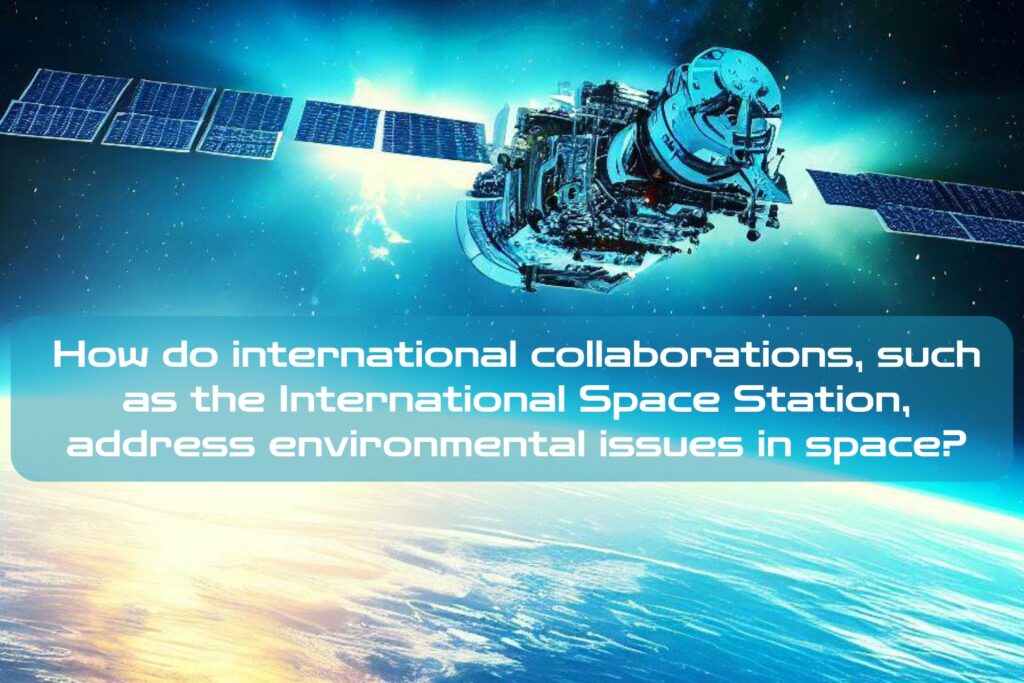International Collaborations and the Environment: A Look at the International Space Station
The Power of Collaboration
International collaborations occur when countries or organizations come together to achieve a common goal. This can be in any field, from science and technology to healthcare or education.
The purpose is to share knowledge, resources, and expertise to achieve something that might be impossible for any one country or organization alone. Collaborations are particularly powerful when addressing environmental issues because these issues often transcend borders.
Climate change, air pollution, and water quality are just a few examples of problems that require global solutions. By working together, scientists and researchers from different countries can pool their knowledge and resources to tackle these complex challenges.
The International Space Station: A Brief Overview
The International Space Station (ISS) is one of the most significant international collaborations in history. It was launched in 1998 as a joint project between NASA, Roscosmos (the Russian space agency), the European Space Agency (ESA), the Canadian Space Agency (CSA), and the Japan Aerospace Exploration Agency (JAXA).
The ISS is a habitable artificial satellite that orbits the Earth at an altitude of approximately 408 kilometers. The ISS serves as an incredible example of what can be achieved through international collaboration.
It required cooperation between five different space agencies, each with their own culture, language, and technical systems. Yet despite these challenges, they managed to create an incredible achievement – something greater than any one nation could have accomplished alone.
The Importance of Addressing Environmental Issues Through Collaboration

Environmental issues are pressing concerns for our planet’s future. Many problems we face today cannot be solved by one country alone; they require global solutions through international collaborations. The ISS provides an excellent example of how collaboration can effectively address environmental concerns.
One way the ISS addresses environmental issues is by reducing carbon footprint. The use of solar panels to generate power has reduced the use of fossil fuels, contributing to a clean energy future.
In addition, the ISS has been used to study climate change and understand its impact from a global perspective. This knowledge is then shared with different countries through collaborations between scientists and researchers.
These are just some of the ways in which international collaborations, such as those seen on the ISS, can address environmental issues. By working together, we can make progress towards a sustainable future for our planet.
Environmental Benefits of the ISS

Reducing the Carbon Footprint
The International Space Station (ISS) is doing its part in addressing environmental concerns by reducing its carbon footprint. The ISS uses solar panels to generate electricity, which reduces their dependence on non-renewable energy sources like coal and oil. Furthermore, all the crew members follow a strict sustainability protocol to reduce waste generation, conserve water, and minimize energy consumption.
One of the significant ways the ISS reduces its carbon footprint is by launching fewer rockets to supply resources like food, water, and other essential supplies. By maximizing the use of available space in each rocket launch and recycling wastewater for drinking purposes, they have significantly reduced the number of necessary launches.
Advancements in Renewable Energy Technology
The ISS also plays a pivotal role in advancing renewable energy technology for space exploration. The station’s solar panels are vital for powering various onboard equipment that sustains life aboard it. Scientists and engineers are continually working on making these solar panels more efficient, durable, and cost-effective for future space missions.
In addition to solar power, there is ongoing research on developing other forms of sustainable energy, such as using hydrogen fuel cells or harnessing kinetic energy from spacecraft motion. These renewable technologies will be essential when humans embark on long-duration space missions to explore Mars or beyond.
Understanding Climate Change from a Global Perspective

The International Space Station provides an excellent vantage point for studying climate change from a global perspective. It orbits at an altitude of approximately 408 km above Earth’s surface, which provides scientists with unique opportunities to study natural phenomena like hurricanes, cyclones, melting polar ice caps and wildfires. Scientists can collect valuable data by observing weather patterns over extended periods while monitoring greenhouse gases’ concentration levels in the Earth’s atmosphere.
This information helps researchers understand how climate change impacts our planet’s natural processes and how it can be mitigated to reduce its long-term effects. By working collaboratively, ISS scientists are helping humanity better understand environmental challenges and how to address them.
Collaboration and Cooperation on Environmental Research

Sharing data and findings between countries
One of the major benefits of international collaborations in environmental research is the ability to share data and findings between countries. This collaboration allows researchers to access a wider range of data than they would if they were working alone, which can lead to more comprehensive research outcomes.
By sharing their findings with one another, countries can also learn from each other’s successes and failures, which can help them to develop better strategies for addressing environmental problems. For example, the International Space Station has allowed for international cooperation on research related to climate change.
Data collected from various instruments onboard the ISS is shared among international partners, allowing for a more robust analysis of the earth’s climate patterns. This cross-referencing helps scientists make sense of otherwise isolated pieces of information that come from different parts of the world.
Collaborative research on climate change, pollution, and other environmental issues
In addition to sharing data and findings, collaborative research is also an essential part of international collaborations in environmental research. Collaborative research allows scientists from different countries to work together towards shared goals or objectives.
The results are often much more impactful than if each country worked separately. For example, NASA’s Earth Science Division has partnered with space agencies from Canada and France on a joint project called Surface Water Ocean Topography (SWOT).
SWOT will produce high-resolution measurements of earth’s surface water by mapping out rivers, lakes, and streams across the globe in real-time using satellite imagery. Such collaborative projects hold enormous potential for understanding ocean currents and weather patterns across the world.
Development of sustainable technologies for space exploration

International collaborations have also led to significant advancements in sustainable technologies that have helped reduce humanity’s impact on planet Earth through space exploration efforts. For instance, NASA has been researching ways to reduce its environmental footprint by developing new technologies for its space vehicles.
These technologies include solar-electric propulsion, which uses electricity generated from solar panels to power spacecraft for extended periods. International collaborations have also led to the development of new recycling and waste management technologies that have helped reduce the amount of waste produced during space missions.
The European Space Agency has developed a device called the ECLSS (Environmental Control and Life Support System), which recycles water and air on board spacecraft, reducing the need for resupply trips with fresh water and oxygen. International collaboration plays an essential role in environmental research.
Collaborative research can lead to more comprehensive findings, sharing data allows researchers access to a wider range of information, and sustainable technologies are being developed that will help reduce humanity’s impact on planet Earth through space exploration efforts. By working together towards common goals, countries can make significant progress in addressing the environmental problems facing us today.
Differences in Cultural Values and Priorities

One of the biggest challenges faced by international collaborations is the difference in cultural values and priorities. Each country has its own unique set of beliefs, customs, and practices, which can impact their approach to environmental issues.
For example, some cultures prioritize economic growth over environmental protection, while others may view environmental conservation as a critical component of their cultural identity. These differences can create significant hurdles when trying to establish international environmental policies or implement sustainability initiatives.
It requires finding a balance between respecting each other’s values while also working towards a common goal. It is essential to acknowledge these differences and work together towards finding solutions that are acceptable to everyone involved.
Political Challenges That Can Hinder Progress

Politics can also play a significant role in hindering progress towards addressing environmental issues. Political tensions between countries can lead to delays in decision-making or block progress entirely.
Additionally, political leaders’ priorities may not align with the goals of international collaborations on environmental issues. For example, some politicians may prioritize short-term economic gains over long-term sustainability goals.
Others may be unwilling to make politically unpopular decisions that are necessary for effective, sustainable practices. To overcome these challenges, it is crucial for organizations and policymakers involved in international collaborations on environmental issues to always prioritize open communication lines so that they can navigate political challenges effectively.
Technical Challenges That Arise from Working with Different Countries’ Systems

The technical challenges faced by international collaborations are another significant hurdle that needs addressing. Every country has its own unique systems for energy production, transportation systems for waste management, and regulations regarding emissions control.
When multiple countries work together on an environmentally-focused project like the International Space Station (ISS), they must overcome these technical differences before they begin working together effectively. For instance, different countries have different approaches when it comes to renewable energy technology or climate modeling techniques; therefore, there must be an agreement on which systems to use for international collaborations.
To address these technical challenges, it is critical to build a framework that enables the exchange of technical knowledge and expertise. This exchange should be a two-way street where countries can share their technology and knowledge but also learn from each other’s approach to environmental conservation.
Final Thoughts
The Importance of International Collaboration to Address Environmental Issues

International collaboration is crucial when addressing environmental issues that affect the entire planet. It is not just a responsibility, but also an opportunity for countries to come together and create innovative solutions to protect our planet.
The fact that countries like the US, Russia, Europe, Canada, and Japan have come together to build and operate the International Space Station (ISS) is a testament to the power of collaboration. The collective knowledge and resources of different countries can be combined to address various environmental issues.
Partnerships are essential for sharing information and reducing duplication of efforts in research on climate change, renewable energy sources, and pollution prevention, among other things. International collaboration allows us to pool resources towards achieving common goals.
The Role That the ISS Plays in Promoting Sustainable Practices
The ISS plays a significant role in promoting sustainable practices through initiatives such as recycling water and air systems used on board. These systems demonstrate how scarce resources can be reused sustainably without compromising human health or overall mission success. Additionally, experiments conducted onboard the station contribute towards developing new technologies that promote sustainable living on earth.
For instance, portable water filtration systems developed for use on board the ISS can be adapted for terrestrial use, particularly in areas with limited access to clean water sources. The lessons learned from space-based sustainability efforts can help inform more sustainable practices here on Earth.
The Future Potential for International Collaborations To Further Advance Environmental Research
International collaborations will continue to grow as more challenges emerge, with climate change’s effects becoming more pronounced worldwide. Developing nations, which bear most of these detrimental effects, might look up international collaborations as an essential part of their success story out of poverty or under-development.
International cooperation such as that seen with ISS represents only one facet of what we can achieve when we work together towards shared aims. By pooling resources across borders, nations can work more effectively in tackling global environmental problems, and the future potential for collaboration is limitless.
FAQ: International Collaborations and Addressing Environmental Issues in Space

1. What is the International Space Station (ISS) and how does it relate to environmental issues in space?
– The International Space Station (ISS) is a multinational space station that serves as a research laboratory and living space for astronauts from various countries.
– Regarding environmental issues in space, the ISS plays a crucial role in studying and addressing these concerns through international collaborations.
2. Why is addressing environmental issues in space important?
– Addressing environmental issues in space is vital for the sustainability and long-term viability of space exploration and human activities beyond Earth.
– Understanding and mitigating these issues can help preserve celestial bodies, protect astronauts’ health, and ensure responsible exploration.
3. How do international collaborations contribute to addressing environmental issues in space?
– International collaborations enable the pooling of resources, knowledge, and expertise from multiple countries, facilitating comprehensive studies on environmental issues in space.
– Collaborative efforts allow for the sharing of research findings, data, and technologies, leading to more effective solutions and strategies.
4. What are some specific environmental issues that international collaborations address in space?
– One significant environmental concern is space debris, including defunct satellites, spent rocket stages, and other debris fragments. Collaborations focus on tracking, monitoring, and mitigating space debris to reduce the risk of collisions and preserve space sustainability.
– Another concern is the impact of space exploration activities on celestial bodies, such as the Moon and Mars. Collaborative efforts aim to minimize contamination and protect these extraterrestrial environments during missions.
– The effects of microgravity on astronauts’ health and the environment are also studied through international collaborations. Understanding these effects helps develop countermeasures and ensure the well-being of crew members.
5. How do international collaborations address the issue of space debris?
– International collaborations establish shared tracking systems, which monitor the positions of space debris objects and predict potential collisions with operational spacecraft.
– Collaborative efforts also focus on developing technologies to actively remove space debris, such as capturing and deorbiting defunct satellites or using nets and harpoons to capture smaller debris fragments.
– Additionally, collaborations work towards implementing responsible practices in space operations, including satellite design for reduced debris generation and responsible disposal methods.
6. How do international collaborations minimize contamination on celestial bodies?
– Collaborations develop protocols and guidelines for spacecraft sterilization before missions to celestial bodies like the Moon and Mars.
– These protocols ensure that potential biological contamination from Earth, such as microorganisms, is minimized to preserve the scientific integrity of these extraterrestrial environments.
– International collaborations also prioritize the study of planetary protection, which aims to prevent contamination from returning samples or spacecraft to Earth.
7. How do international collaborations address the effects of microgravity on astronauts’ health and the environment?
– Through collaborative efforts, researchers conduct experiments on the ISS to study the physiological and psychological impacts of microgravity on astronauts.
– These studies help identify potential health risks and develop countermeasures such as exercise routines and dietary plans to mitigate these effects.
– International collaborations also investigate the effects of microgravity on plants, animals, and other organisms, contributing to our understanding of the broader environmental implications.
8. How does international cooperation benefit space exploration and addressing environmental issues?
– International cooperation fosters a sharing of resources, knowledge, and perspectives, enabling more comprehensive research and problem-solving.
– Collaborative efforts lead to cost-sharing, reducing the financial burden on individual countries and allowing for more ambitious missions and studies.
– By working together, nations can tackle complex environmental challenges more effectively and develop sustainable practices for future space exploration endeavors.
9. What is the role of international space agencies in these collaborations?
– International space agencies, such as NASA, ESA, Roscosmos, JAXA, and others, play a vital role in coordinating and facilitating international collaborations.
– These agencies establish frameworks for cooperation, coordinate research priorities, and facilitate the exchange of information and technology among participating countries.
– They also contribute to policy development, regulatory frameworks, and international agreements related to space exploration and environmental protection.
10. Are there any legal frameworks governing international collaborations and environmental issues in space?
– Yes, international collaborations and environmental issues in space are governed by legal frameworks such as the Outer Space Treaty, which outlines the principles of space exploration and prohibits the placement of weapons of mass destruction in space.
– Additionally, specific guidelines and policies are developed by international space agencies and organizations to address environmental concerns and promote responsible space exploration practices.
TL;DR…
– 💡 International collaborations, such as the International Space Station (ISS), are actively addressing environmental challenges in space.
– 🌍 Collaborations like the ISS contribute to a global understanding of climate change and pollution, enabling comprehensive research and solutions.
– 🤝 Collaboration fosters the sharing of data, findings, and technologies among countries, leading to more effective environmental research.
– 🚀 The ISS plays a crucial role in developing sustainable technologies for space exploration and reducing the carbon footprint.
– 🌱 Advancements in renewable energy technology are being explored through international collaborations in space.
– 🌐 International collaborations help bridge cultural differences and prioritize environmental issues despite varying values and priorities.
– 🚧 Political and technical challenges may arise, but international collaborations are key to overcoming them and making progress.
– ✨ The ISS serves as a platform for promoting sustainable practices and addressing environmental concerns in space.
– 🔮 The future holds great potential for international collaborations to further advance environmental research and solutions.

C M, a seasoned editor, journalist, and consultant, is deeply fascinated by the convergence of technology, space, and the future of humanity.
With a particular interest in transhumanity, futurology, and the philosophical and ethical dimensions of these domains, C M serves as the lead contributor to SpaceSpotlight and TranscendSphere.
When not penning insightful articles on these rapidly evolving fields, C M indulges in their love for podcasts and books, proudly embracing their status as a ‘Happy Nerd Extraordinaire!’



